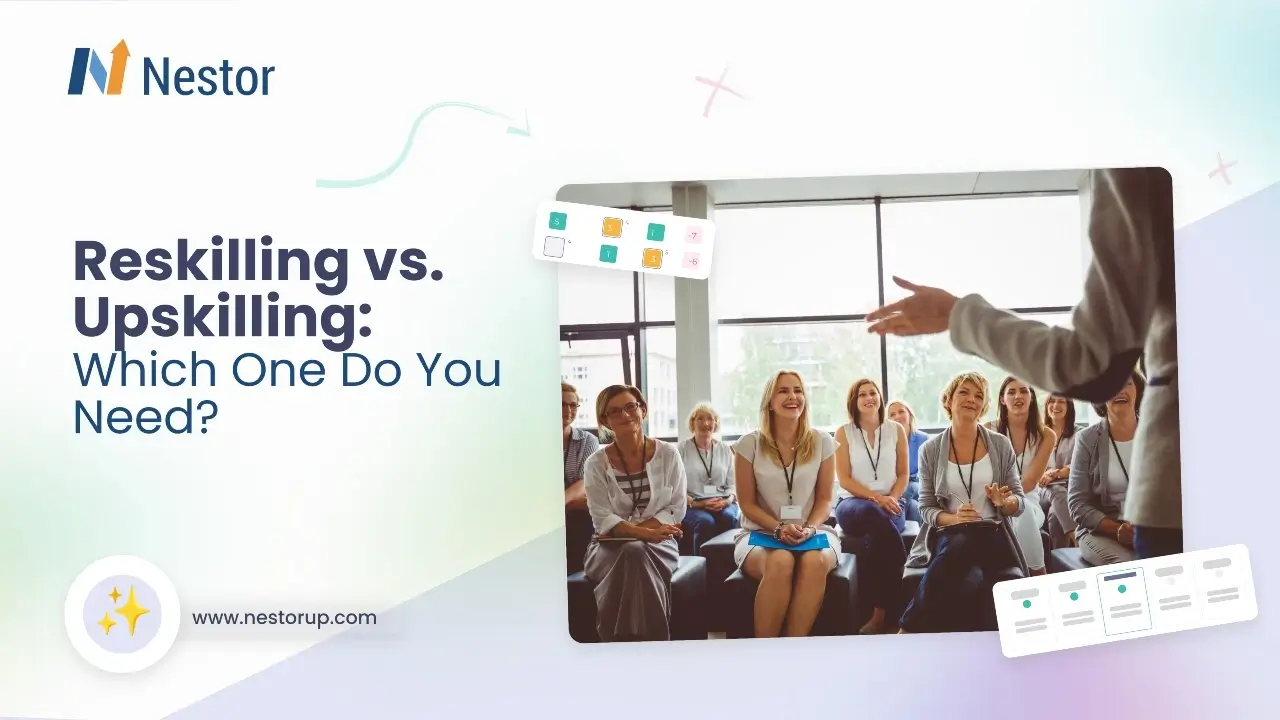
Contents
In a world of helping companies grow, to make sure your employees are on top of their game, two key ideas have become indispensable strategies: reskilling and upskilling. Think of reskilling as giving your employees different new skills from what they currently have. It’s like adding new tools to their toolbox. And upskilling? Well, that’s about enhancing the skills they already have, making them even better at what they do.
Why are these concepts so important? Well, as technology continues to advance and customer demands change, industries are transforming faster than ever before. To stay relevant, businesses need a workforce that can adapt and grow with them.
In this article, we explore the distinct yet complementary approaches of reskilling and upskilling from a company perspective. By getting to know what each one offers, businesses can make sure their team members are ready to tackle anything, ignite fresh insights, and ready to seize opportunities. After all, in today’s world, being adaptable and innovative is key to long-term success.
What is Upskilling?
Upskilling is a proactive approach to professional development aimed at enhancing the skills and competencies of employees within their current field or industry. It involves providing training and learning opportunities to enable individuals to acquire new capabilities, improve existing skills, and adapt to evolving job requirements and technological advancements.
To illustrate this concept, let’s talk about John, an IT support specialist working for a technology company. John possesses strong technical skills in troubleshooting hardware and software issues, but he recognizes the importance of upskilling to keep pace with advancements in the industry.
With the company’s support, John embarks on an upskilling journey by enrolling in specialized training programs focused on emerging technologies such as cloud computing and cybersecurity. He also participates in workshops and seminars to enhance his communication and project management skills, which are essential for collaborating with cross-functional teams and delivering effective IT solutions.
As John continues to upskill himself, he becomes proficient in new technologies and develops a deeper understanding of industry trends and best practices. His enhanced skill set not only boosts his confidence and job satisfaction but also positions him as a valuable asset to the company. With his newfound expertise, John can tackle complex challenges more effectively, contribute to innovation initiatives, and take on leadership roles within his department.
What is Reskilling?
To reskill an employee is a strategic approach to career development, enabling individuals to stay relevant and competitive in rapidly changing industries. It involves equipping them with the knowledge and competencies required to perform new roles or tasks that may emerge due to technological advancements, industry shifts, or changing job requirements. Unlike upskilling, which focuses on enhancing specific skills within the employee’s current field, reskilling employees often involves transitioning them into entirely new roles or industries.
For an easier understanding, let’s look at Maria, a talented social media manager known for her creativity and eye for design. Armed with expertise in platforms like Photoshop and Canva, Maria excelled in crafting engaging social media content for her company. However, as the company’s design needs grew, Maria saw an opportunity to reskill herself and transition into a graphic design role.
Recognizing Maria’s potential, the company supported her reskilling journey by offering access to training resources, mentorship programs, and hands-on learning opportunities. She experimented with design software, honed her typography skills, and mastered the principles of layout and composition.
As Maria’s proficiency in graphic design blossomed, so did her career prospects within the company. When the company needed a new graphic designer to support its growing design initiatives, Maria emerged as the ideal candidate. Having already demonstrated her dedication, creativity, and understanding of the company’s brand, Maria seamlessly transitioned into her new role, bringing fresh perspectives and innovative design solutions to the table.
Understanding the Distinction between Reskilling and Upskilling
Reskilling and upskilling are integral components of talent development strategies within organizations, each serving distinct purposes and objectives. Upskilling primarily revolves around enhancing and expanding the existing skill sets of employees within their current roles or fields.
This involves providing training programs, workshops, and learning opportunities aimed at improving skills needed for either higher-level roles within the same field or for excelling in their current positions. For example, companies might provide advanced training in software tools or technologies relevant to employees’ job roles, to enhance productivity and effectiveness in their current positions or prepare them for more senior roles.
Reskilling initiatives often involve comprehensive training programs designed to prepare employees for emerging job opportunities within the company or to facilitate transitions to new career paths. For example, organizations might provide training initiatives to help employees transition from traditional administrative roles to positions requiring data analysis skills or from manual labor jobs to roles demanding digital literacy and technical expertise.
While upskilling focuses on deepening expertise within the existing job framework, reskilling prepares employees for new roles or career pathways necessitated by evolving business landscapes. Both strategies are crucial for nurturing a team of skilled and flexible individuals capable of meeting the challenges of a dynamic market environment.
By strategically implementing reskilling and upskilling initiatives, organizations can empower their employees to remain relevant, agile, and on top of their game. Moreover, these efforts not only benefit individual employees by enhancing their career prospects and job satisfaction but also contribute to the overall growth and success of the organization.
And it’s not just the company that benefits. When employees are given the chance to grow and develop their skills, it boosts their confidence and job satisfaction. Plus, it opens up new opportunities for them to advance in their careers. So, it’s a win-win situation. Employees get the chance to enhance their skills and maybe even discover new passions or talents along the way, while the company benefits from having a team that’s not only skilled but also adaptable
When to Prioritize Upskilling
The decision to embark on upskilling initiatives can be influenced by many factors, ranging from technological advancements and market shifts to employee feedback and strategic planning. By understanding the triggers for upskilling and strategically implementing relevant programs, organizations can position themselves for long-term success while equipping their employees with the tools they need to excel in their roles.
It’s not merely a matter of reacting to immediate needs, it’s more about taking a step back and looking at the bigger picture — finding ways to help your team grow and improve that fit the company’s strategic objectives and long-term vision.
Think of it like tending to a garden. You don’t just water the plants once and expect them to flourish forever. To see what they need, you have to keep checking in and give them the care they require to thrive. Similarly, with upskilling, it’s about regularly checking in with your team, understanding where they could use some extra support or new skills, and then making sure they get the training and development they need to keep growing.
1. Technological Advancements
New technologies are revolutionizing how businesses operate and engage with their customers, from artificial intelligence and machine learning to blockchain and virtual reality. For example, consider a marketing team tasked with reaching and engaging customers in an increasingly digital world. As data analytics tools become more sophisticated and essential for understanding customer behavior, members of the marketing team may need to upskill in data analysis techniques and tools to leverage customer insights in their campaigns effectively.
3. Performance Improvement
Recognizing and tackling skill gaps or performance challenges in employees is crucial for keeping things running smoothly and reaching our goals as a team. Whether it’s struggling with certain tasks, using outdated skills, or finding it tough to adapt to new ways of working, these are all areas where targeted upskilling can make a big difference.
For instance, consider a scenario where sales representatives within a company are struggling with negotiation skills, leading to missed opportunities and suboptimal outcomes in client interactions. By recognizing this as an area for improvement, the company can implement targeted upskilling workshops or training programs focused on enhancing negotiation techniques and strategies.
4. Market Demand
When the market changes its tune, employees need to adapt to stay in step with what’s happening. Take, for instance, a retail company. If more and more people are shopping online, the sales team might need a boost in their skills to handle this shift. That could mean learning how to navigate e-commerce platforms, understanding online marketing strategies, or even mastering the art of virtual customer service. The company ensures they’re not left behind in the race by upskilling their staff in these areas.
5. Competitive Advantage
In the world of business, companies that are always finding new ways to innovate and adjust to what customers want are the ones that stand out from the crowd. This is where upskilling emerges as a strategic initiative to gain and sustain a competitive advantage.
At the heart of it all, it’s the people who make a company truly stand out. When employees are empowered with the right skills and knowledge, they become the driving force behind innovation and creativity. And it’s not just about staying ahead of the curve; it’s about leading the way. By nurturing a skilled and agile workforce, companies can carve out their path, creating products, services, and experiences that resonate with customers on a deeper level.
When to Prioritize Reskilling
Instead of just sticking to the same old routines, we need to be open to change and ready to adapt. That’s where reskilling comes in. It’s about recognizing when your team members need to learn new skills or explore different paths to keep up with the ever-evolving demands of your industry.
For example, did you know that according to the World Economic Forum’s Future of Jobs Report, it’s estimated that 50% of all employees will need to reskill by 2025? In the swirling currents of today’s workforce, one thing becomes clear: reskilling is like the life jacket that can keep your organization afloat amidst the waves of change.
Reskilling employees is crucial because it allows companies to give customized skill training, which keeps key people on board. Instead of employing fresh talent, reskilling programs are intended to equip existing employees with the necessary abilities to do new jobs or thrive in a different role.
1. Meeting Skill Demands
Reskilling is essential due to the ever-changing skill demands of the workplace as industries evolve and technologies advance. These shifts require employees to continuously adapt and acquire new skills to thrive in their roles. As employees dive into these opportunities, they’re not just learning new skills—they’re gaining a deeper understanding of how your business operates.
For example, employees who participate in cross-functional reskilling programs may gain a deeper understanding of different departments within the organization, from marketing and finance to operations and customer service. Armed with this holistic perspective, these employees can become invaluable problem solvers, leveraging their diverse knowledge to address complex issues and drive innovation across the company.
2. Improves employee retention rates
By investing in reskilling programs, companies can retain their existing employees who may otherwise seek opportunities elsewhere due to a lack of career growth or relevance. Retaining employees avoids the need to recruit and onboard new talent, which can be a costly process involving advertising, interviewing, and training expenses.
3. Reduces hiring costs
Avoiding employee turnover reduces the need for recruitment efforts, which can be both time-consuming and costly. And it’s not just about holding onto talent; it’s also a smart business move. Recruiting expenses include advertising job openings, conducting interviews, and providing training for new hires.
By retaining skilled and experienced employees through this initiative, companies can save on these recruitment and onboarding expenses. A study conducted by the Financial Services Skills Commission shows that hiring a new individual costs more than double compared to reskilling an existing employee.
4. Business Expansion or Diversification
When organizations expand into new markets or diversify their product/service offerings, reskilling may be required to support these initiatives. Consider, for instance, a scenario where a retail company entering the e-commerce space may need to reskill employees to manage online sales platforms and engage with customers through digital channels.
5. Global Events:
Major events such as economic downturns or pandemics can create the need for reskilling. The best example is the COVID-19 pandemic, when many businesses shifted to remote work, requiring employees to reskill in digital collaboration tools and remote work best practices.
In essence, reskilling and upskilling are not just strategies; they are imperatives for organizations seeking to navigate the complexities of the modern workplace and unlock the full potential of their workforce. By proactively addressing skills gaps and equipping employees with the tools and knowledge needed to adapt to changing circumstances, companies can mitigate risks and seize opportunities for growth and innovation.
Frequently Asked Questions (FAQs) about upskilling and reskilling
1. What is the difference between upskilling and reskilling?
Upskilling involves enhancing and expanding existing skill sets within the current field or role while reskilling focuses on equipping employees with entirely new skills or transitioning them into different roles or industries.
2. When should organizations consider upskilling?
Organizations should consider upskilling when faced with factors such as technological advancements, performance improvement opportunities, changing market demands, or the pursuit of a competitive advantage.
When it comes to upskilling, utilizing predictive analytics and nudging automation, platforms like Nestor can identify skill gaps and guide employees toward growth opportunities aligned with organizational goals. These insights can help organizations make informed decisions about when and how to invest in upskilling initiatives.
3. When should organizations consider reskilling?
Organizations should consider reskilling when addressing skill demands, improving employee retention rates, reducing hiring costs, supporting business expansion or diversification, or responding to global events such as economic downturns or pandemics.
Platforms like Nestor facilitate reskilling by tracking employees’ progress in their reskilling journey, providing insights into their development, conducting skills assessments to evaluate current proficiency levels and areas for improvement, and adjusting their growth plans as they advance in their journey to acquire new skills.
4. How do I implement effective upskilling and reskilling programs?
Implementing effective upskilling and reskilling programs involves several key steps. First, it’s essential to assess the current skill levels and identify areas where improvement is needed. This can be done through skills assessments, performance evaluations, and feedback from employees. Once skill gaps are identified, develop a comprehensive training plan that includes a mix of formal training, workshops, on-the-job learning, and mentoring opportunities.
It’s crucial to tailor these programs to meet the specific needs and learning styles of employees. Additionally, provide ample support and resources to participants throughout the program, including access to learning materials, guidance from mentors, and regular check-ins to track progress. Finally, evaluate the effectiveness of the programs regularly and make adjustments as needed to ensure continuous improvement and alignment with organizational goals.








